Construction Management Report: Industrial Complex Development
VerifiedAdded on 2022/08/27
|12
|3473
|17
Report
AI Summary
This report provides a comprehensive overview of the construction industry, analyzing its evolution, key stages, and the role of construction companies. It examines the industry's shift towards ethical practices, professionalism, and the adoption of new technologies to improve efficiency and sustainability. The report uses a case study involving the development of an industrial complex to illustrate how construction companies can adapt to industry changes, manage relationships with stakeholders, and implement effective project management techniques, including the use of Gantt charts and Building Information Modeling (BIM). It also discusses various aspects of construction companies, including different types (small renovation contractors, general contractors, real estate developers, and package builders) and the importance of establishing effective communication and trust between them. The report further highlights the importance of sustainable development, the adoption of modern construction processes, and the use of innovation within the industry to achieve organizational effectiveness and strategic goals. The report emphasizes the importance of ethical decision-making and professionalism within the construction industry.
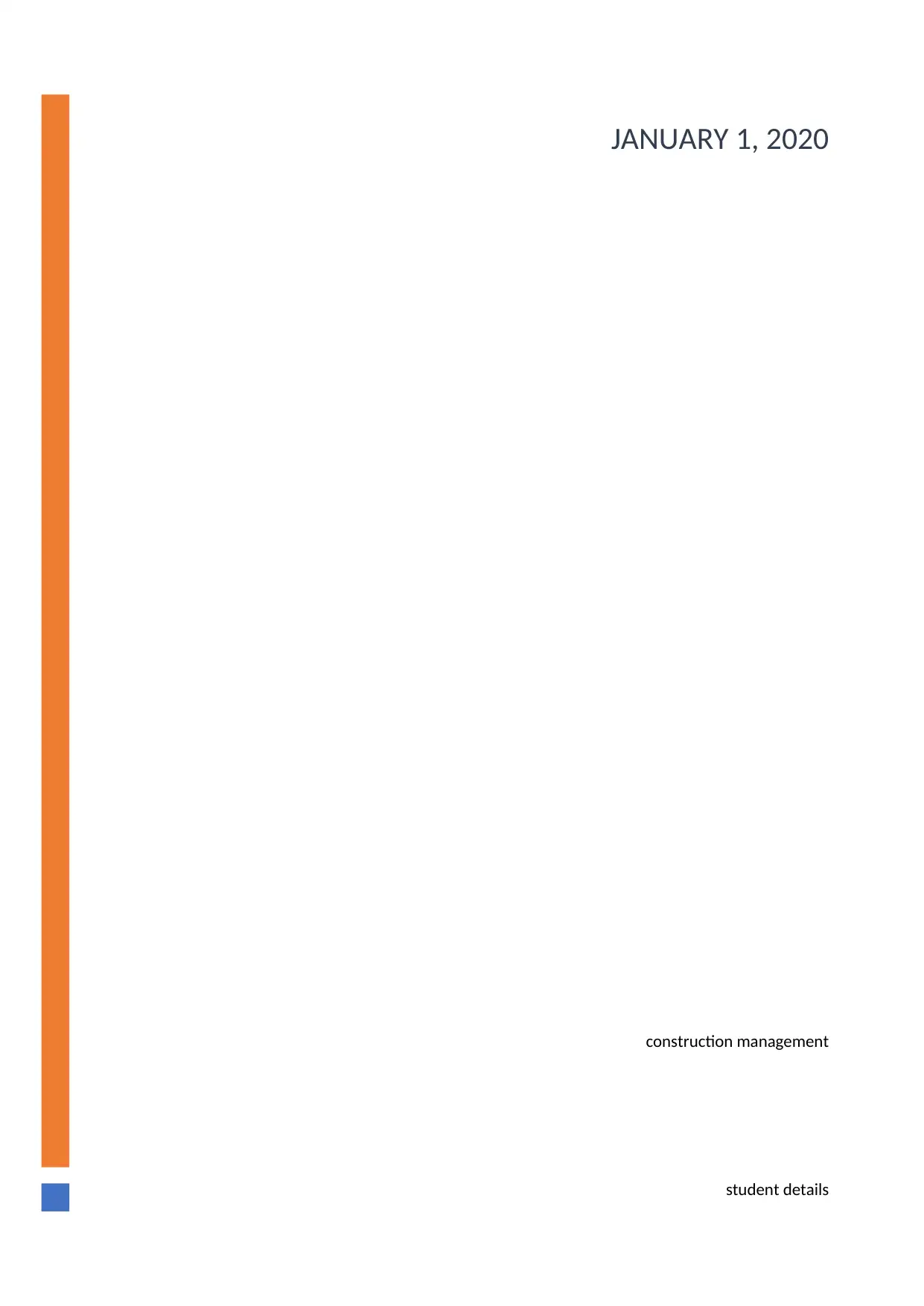
construction management
student details
JANUARY 1, 2020
student details
JANUARY 1, 2020
Paraphrase This Document
Need a fresh take? Get an instant paraphrase of this document with our AI Paraphraser
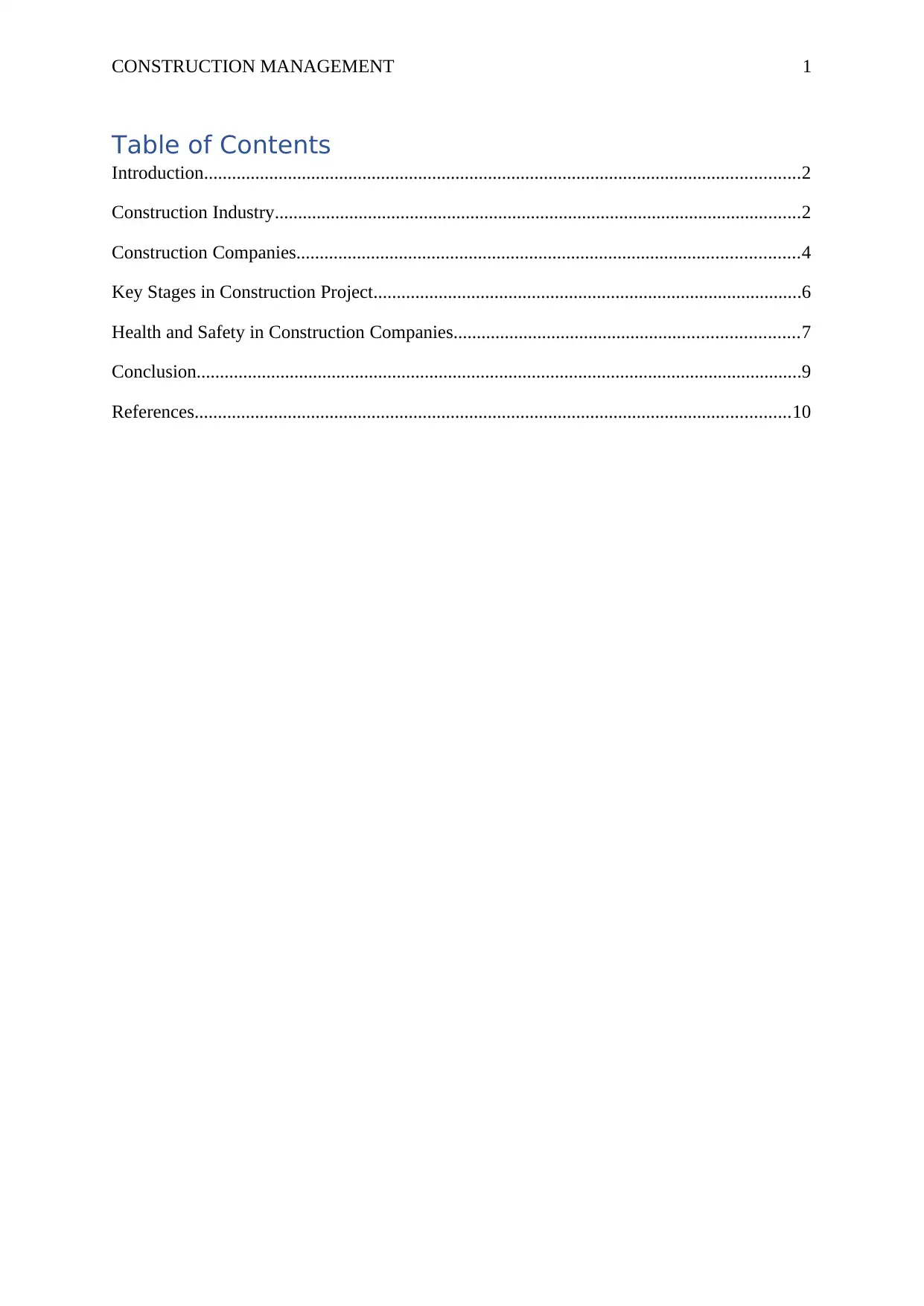
CONSTRUCTION MANAGEMENT 1
Table of Contents
Introduction................................................................................................................................2
Construction Industry.................................................................................................................2
Construction Companies............................................................................................................4
Key Stages in Construction Project............................................................................................6
Health and Safety in Construction Companies..........................................................................7
Conclusion..................................................................................................................................9
References................................................................................................................................10
Table of Contents
Introduction................................................................................................................................2
Construction Industry.................................................................................................................2
Construction Companies............................................................................................................4
Key Stages in Construction Project............................................................................................6
Health and Safety in Construction Companies..........................................................................7
Conclusion..................................................................................................................................9
References................................................................................................................................10
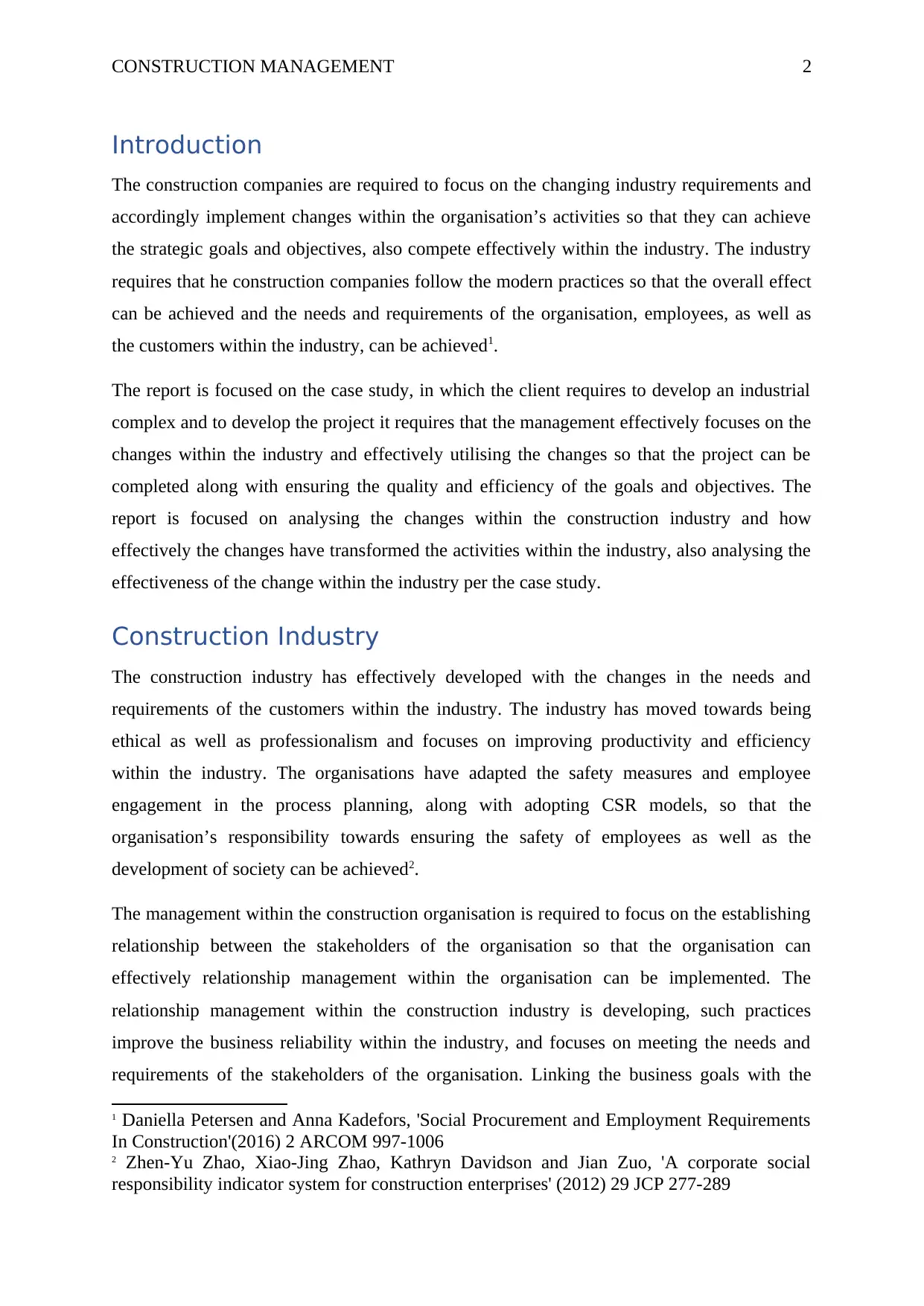
CONSTRUCTION MANAGEMENT 2
Introduction
The construction companies are required to focus on the changing industry requirements and
accordingly implement changes within the organisation’s activities so that they can achieve
the strategic goals and objectives, also compete effectively within the industry. The industry
requires that he construction companies follow the modern practices so that the overall effect
can be achieved and the needs and requirements of the organisation, employees, as well as
the customers within the industry, can be achieved1.
The report is focused on the case study, in which the client requires to develop an industrial
complex and to develop the project it requires that the management effectively focuses on the
changes within the industry and effectively utilising the changes so that the project can be
completed along with ensuring the quality and efficiency of the goals and objectives. The
report is focused on analysing the changes within the construction industry and how
effectively the changes have transformed the activities within the industry, also analysing the
effectiveness of the change within the industry per the case study.
Construction Industry
The construction industry has effectively developed with the changes in the needs and
requirements of the customers within the industry. The industry has moved towards being
ethical as well as professionalism and focuses on improving productivity and efficiency
within the industry. The organisations have adapted the safety measures and employee
engagement in the process planning, along with adopting CSR models, so that the
organisation’s responsibility towards ensuring the safety of employees as well as the
development of society can be achieved2.
The management within the construction organisation is required to focus on the establishing
relationship between the stakeholders of the organisation so that the organisation can
effectively relationship management within the organisation can be implemented. The
relationship management within the construction industry is developing, such practices
improve the business reliability within the industry, and focuses on meeting the needs and
requirements of the stakeholders of the organisation. Linking the business goals with the
1 Daniella Petersen and Anna Kadefors, 'Social Procurement and Employment Requirements
In Construction'(2016) 2 ARCOM 997-1006
2 Zhen-Yu Zhao, Xiao-Jing Zhao, Kathryn Davidson and Jian Zuo, 'A corporate social
responsibility indicator system for construction enterprises' (2012) 29 JCP 277-289
Introduction
The construction companies are required to focus on the changing industry requirements and
accordingly implement changes within the organisation’s activities so that they can achieve
the strategic goals and objectives, also compete effectively within the industry. The industry
requires that he construction companies follow the modern practices so that the overall effect
can be achieved and the needs and requirements of the organisation, employees, as well as
the customers within the industry, can be achieved1.
The report is focused on the case study, in which the client requires to develop an industrial
complex and to develop the project it requires that the management effectively focuses on the
changes within the industry and effectively utilising the changes so that the project can be
completed along with ensuring the quality and efficiency of the goals and objectives. The
report is focused on analysing the changes within the construction industry and how
effectively the changes have transformed the activities within the industry, also analysing the
effectiveness of the change within the industry per the case study.
Construction Industry
The construction industry has effectively developed with the changes in the needs and
requirements of the customers within the industry. The industry has moved towards being
ethical as well as professionalism and focuses on improving productivity and efficiency
within the industry. The organisations have adapted the safety measures and employee
engagement in the process planning, along with adopting CSR models, so that the
organisation’s responsibility towards ensuring the safety of employees as well as the
development of society can be achieved2.
The management within the construction organisation is required to focus on the establishing
relationship between the stakeholders of the organisation so that the organisation can
effectively relationship management within the organisation can be implemented. The
relationship management within the construction industry is developing, such practices
improve the business reliability within the industry, and focuses on meeting the needs and
requirements of the stakeholders of the organisation. Linking the business goals with the
1 Daniella Petersen and Anna Kadefors, 'Social Procurement and Employment Requirements
In Construction'(2016) 2 ARCOM 997-1006
2 Zhen-Yu Zhao, Xiao-Jing Zhao, Kathryn Davidson and Jian Zuo, 'A corporate social
responsibility indicator system for construction enterprises' (2012) 29 JCP 277-289
⊘ This is a preview!⊘
Do you want full access?
Subscribe today to unlock all pages.

Trusted by 1+ million students worldwide
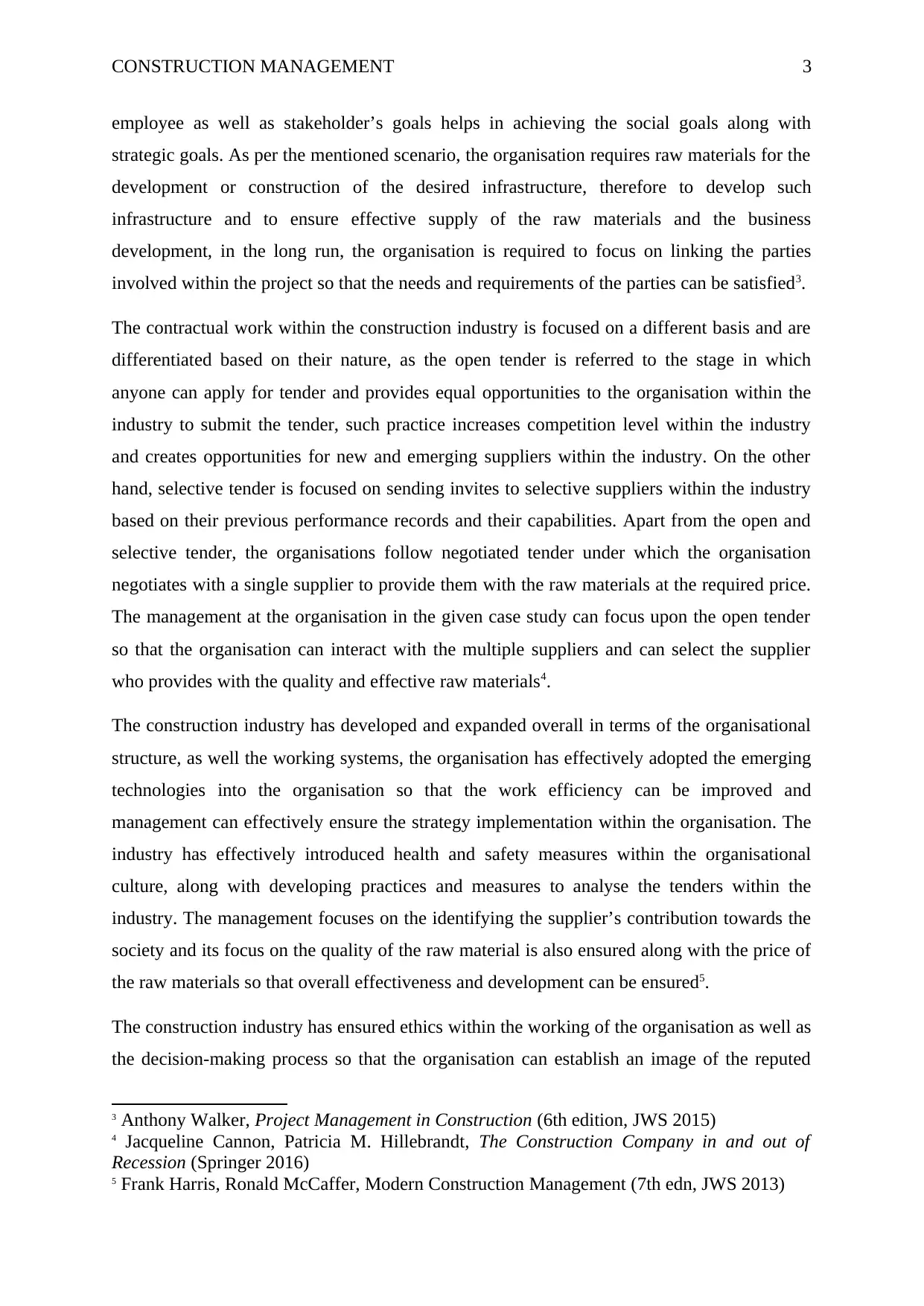
CONSTRUCTION MANAGEMENT 3
employee as well as stakeholder’s goals helps in achieving the social goals along with
strategic goals. As per the mentioned scenario, the organisation requires raw materials for the
development or construction of the desired infrastructure, therefore to develop such
infrastructure and to ensure effective supply of the raw materials and the business
development, in the long run, the organisation is required to focus on linking the parties
involved within the project so that the needs and requirements of the parties can be satisfied3.
The contractual work within the construction industry is focused on a different basis and are
differentiated based on their nature, as the open tender is referred to the stage in which
anyone can apply for tender and provides equal opportunities to the organisation within the
industry to submit the tender, such practice increases competition level within the industry
and creates opportunities for new and emerging suppliers within the industry. On the other
hand, selective tender is focused on sending invites to selective suppliers within the industry
based on their previous performance records and their capabilities. Apart from the open and
selective tender, the organisations follow negotiated tender under which the organisation
negotiates with a single supplier to provide them with the raw materials at the required price.
The management at the organisation in the given case study can focus upon the open tender
so that the organisation can interact with the multiple suppliers and can select the supplier
who provides with the quality and effective raw materials4.
The construction industry has developed and expanded overall in terms of the organisational
structure, as well the working systems, the organisation has effectively adopted the emerging
technologies into the organisation so that the work efficiency can be improved and
management can effectively ensure the strategy implementation within the organisation. The
industry has effectively introduced health and safety measures within the organisational
culture, along with developing practices and measures to analyse the tenders within the
industry. The management focuses on the identifying the supplier’s contribution towards the
society and its focus on the quality of the raw material is also ensured along with the price of
the raw materials so that overall effectiveness and development can be ensured5.
The construction industry has ensured ethics within the working of the organisation as well as
the decision-making process so that the organisation can establish an image of the reputed
3 Anthony Walker, Project Management in Construction (6th edition, JWS 2015)
4 Jacqueline Cannon, Patricia M. Hillebrandt, The Construction Company in and out of
Recession (Springer 2016)
5 Frank Harris, Ronald McCaffer, Modern Construction Management (7th edn, JWS 2013)
employee as well as stakeholder’s goals helps in achieving the social goals along with
strategic goals. As per the mentioned scenario, the organisation requires raw materials for the
development or construction of the desired infrastructure, therefore to develop such
infrastructure and to ensure effective supply of the raw materials and the business
development, in the long run, the organisation is required to focus on linking the parties
involved within the project so that the needs and requirements of the parties can be satisfied3.
The contractual work within the construction industry is focused on a different basis and are
differentiated based on their nature, as the open tender is referred to the stage in which
anyone can apply for tender and provides equal opportunities to the organisation within the
industry to submit the tender, such practice increases competition level within the industry
and creates opportunities for new and emerging suppliers within the industry. On the other
hand, selective tender is focused on sending invites to selective suppliers within the industry
based on their previous performance records and their capabilities. Apart from the open and
selective tender, the organisations follow negotiated tender under which the organisation
negotiates with a single supplier to provide them with the raw materials at the required price.
The management at the organisation in the given case study can focus upon the open tender
so that the organisation can interact with the multiple suppliers and can select the supplier
who provides with the quality and effective raw materials4.
The construction industry has developed and expanded overall in terms of the organisational
structure, as well the working systems, the organisation has effectively adopted the emerging
technologies into the organisation so that the work efficiency can be improved and
management can effectively ensure the strategy implementation within the organisation. The
industry has effectively introduced health and safety measures within the organisational
culture, along with developing practices and measures to analyse the tenders within the
industry. The management focuses on the identifying the supplier’s contribution towards the
society and its focus on the quality of the raw material is also ensured along with the price of
the raw materials so that overall effectiveness and development can be ensured5.
The construction industry has ensured ethics within the working of the organisation as well as
the decision-making process so that the organisation can establish an image of the reputed
3 Anthony Walker, Project Management in Construction (6th edition, JWS 2015)
4 Jacqueline Cannon, Patricia M. Hillebrandt, The Construction Company in and out of
Recession (Springer 2016)
5 Frank Harris, Ronald McCaffer, Modern Construction Management (7th edn, JWS 2013)
Paraphrase This Document
Need a fresh take? Get an instant paraphrase of this document with our AI Paraphraser
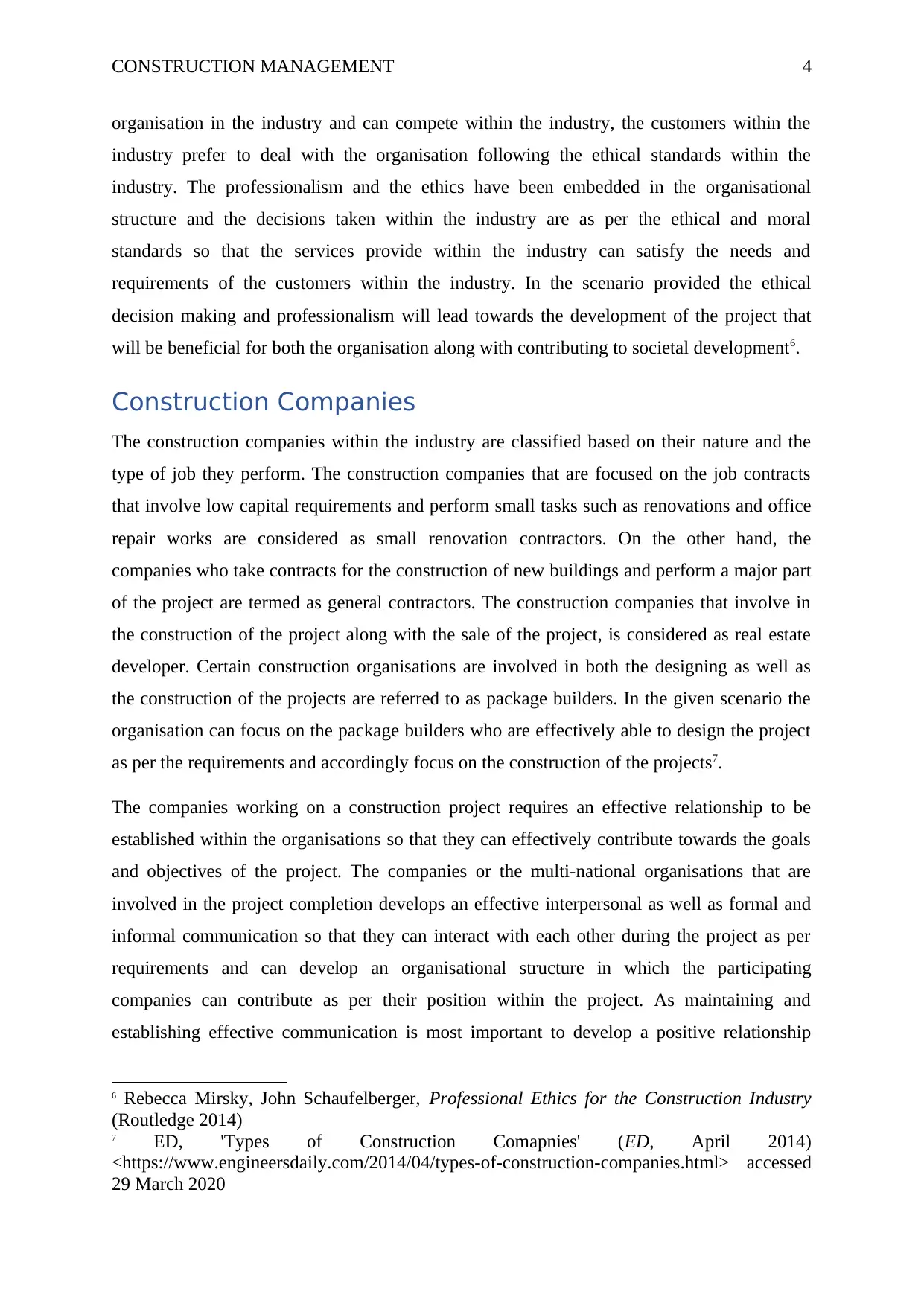
CONSTRUCTION MANAGEMENT 4
organisation in the industry and can compete within the industry, the customers within the
industry prefer to deal with the organisation following the ethical standards within the
industry. The professionalism and the ethics have been embedded in the organisational
structure and the decisions taken within the industry are as per the ethical and moral
standards so that the services provide within the industry can satisfy the needs and
requirements of the customers within the industry. In the scenario provided the ethical
decision making and professionalism will lead towards the development of the project that
will be beneficial for both the organisation along with contributing to societal development6.
Construction Companies
The construction companies within the industry are classified based on their nature and the
type of job they perform. The construction companies that are focused on the job contracts
that involve low capital requirements and perform small tasks such as renovations and office
repair works are considered as small renovation contractors. On the other hand, the
companies who take contracts for the construction of new buildings and perform a major part
of the project are termed as general contractors. The construction companies that involve in
the construction of the project along with the sale of the project, is considered as real estate
developer. Certain construction organisations are involved in both the designing as well as
the construction of the projects are referred to as package builders. In the given scenario the
organisation can focus on the package builders who are effectively able to design the project
as per the requirements and accordingly focus on the construction of the projects7.
The companies working on a construction project requires an effective relationship to be
established within the organisations so that they can effectively contribute towards the goals
and objectives of the project. The companies or the multi-national organisations that are
involved in the project completion develops an effective interpersonal as well as formal and
informal communication so that they can interact with each other during the project as per
requirements and can develop an organisational structure in which the participating
companies can contribute as per their position within the project. As maintaining and
establishing effective communication is most important to develop a positive relationship
6 Rebecca Mirsky, John Schaufelberger, Professional Ethics for the Construction Industry
(Routledge 2014)
7 ED, 'Types of Construction Comapnies' (ED, April 2014)
<https://www.engineersdaily.com/2014/04/types-of-construction-companies.html> accessed
29 March 2020
organisation in the industry and can compete within the industry, the customers within the
industry prefer to deal with the organisation following the ethical standards within the
industry. The professionalism and the ethics have been embedded in the organisational
structure and the decisions taken within the industry are as per the ethical and moral
standards so that the services provide within the industry can satisfy the needs and
requirements of the customers within the industry. In the scenario provided the ethical
decision making and professionalism will lead towards the development of the project that
will be beneficial for both the organisation along with contributing to societal development6.
Construction Companies
The construction companies within the industry are classified based on their nature and the
type of job they perform. The construction companies that are focused on the job contracts
that involve low capital requirements and perform small tasks such as renovations and office
repair works are considered as small renovation contractors. On the other hand, the
companies who take contracts for the construction of new buildings and perform a major part
of the project are termed as general contractors. The construction companies that involve in
the construction of the project along with the sale of the project, is considered as real estate
developer. Certain construction organisations are involved in both the designing as well as
the construction of the projects are referred to as package builders. In the given scenario the
organisation can focus on the package builders who are effectively able to design the project
as per the requirements and accordingly focus on the construction of the projects7.
The companies working on a construction project requires an effective relationship to be
established within the organisations so that they can effectively contribute towards the goals
and objectives of the project. The companies or the multi-national organisations that are
involved in the project completion develops an effective interpersonal as well as formal and
informal communication so that they can interact with each other during the project as per
requirements and can develop an organisational structure in which the participating
companies can contribute as per their position within the project. As maintaining and
establishing effective communication is most important to develop a positive relationship
6 Rebecca Mirsky, John Schaufelberger, Professional Ethics for the Construction Industry
(Routledge 2014)
7 ED, 'Types of Construction Comapnies' (ED, April 2014)
<https://www.engineersdaily.com/2014/04/types-of-construction-companies.html> accessed
29 March 2020
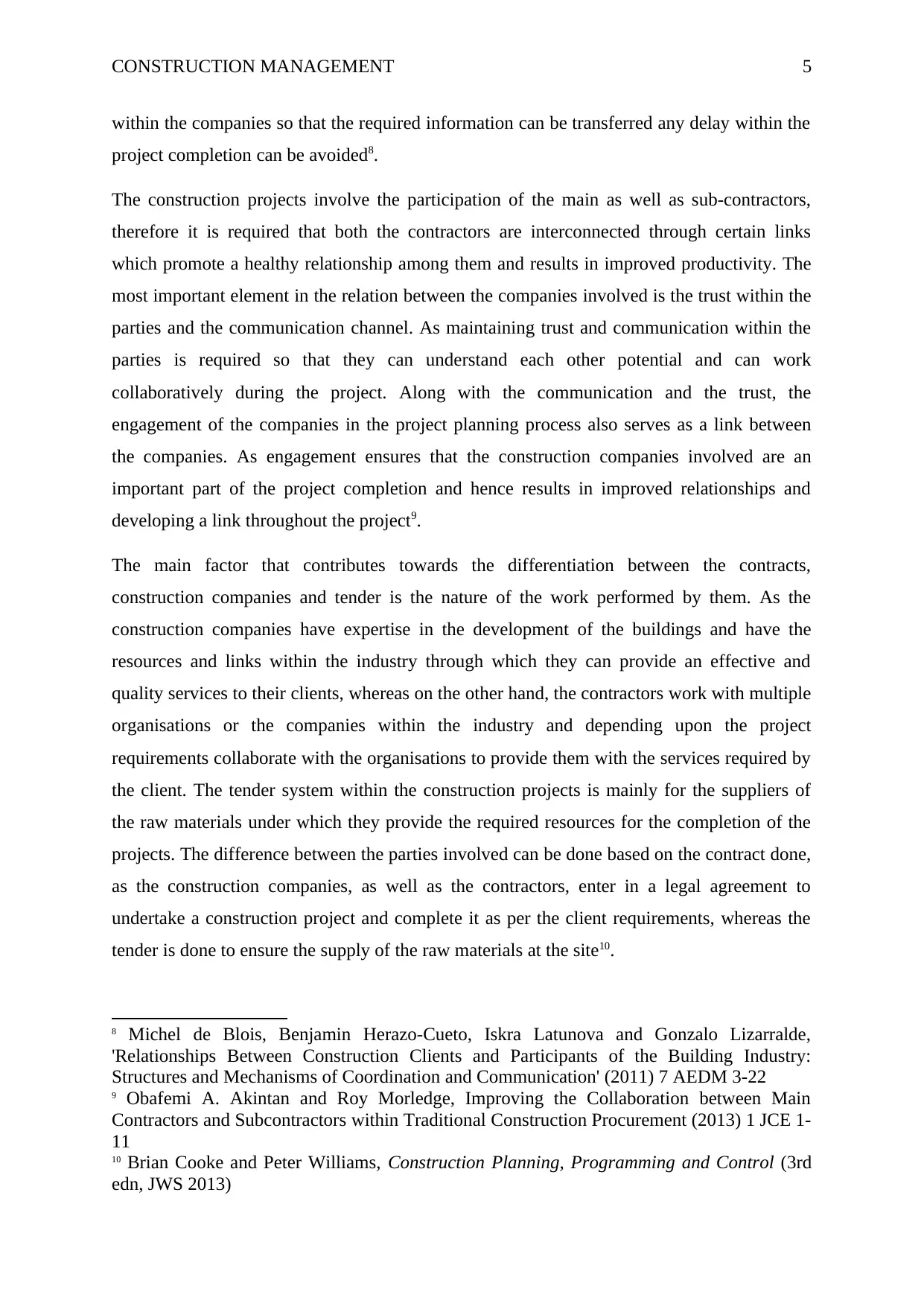
CONSTRUCTION MANAGEMENT 5
within the companies so that the required information can be transferred any delay within the
project completion can be avoided8.
The construction projects involve the participation of the main as well as sub-contractors,
therefore it is required that both the contractors are interconnected through certain links
which promote a healthy relationship among them and results in improved productivity. The
most important element in the relation between the companies involved is the trust within the
parties and the communication channel. As maintaining trust and communication within the
parties is required so that they can understand each other potential and can work
collaboratively during the project. Along with the communication and the trust, the
engagement of the companies in the project planning process also serves as a link between
the companies. As engagement ensures that the construction companies involved are an
important part of the project completion and hence results in improved relationships and
developing a link throughout the project9.
The main factor that contributes towards the differentiation between the contracts,
construction companies and tender is the nature of the work performed by them. As the
construction companies have expertise in the development of the buildings and have the
resources and links within the industry through which they can provide an effective and
quality services to their clients, whereas on the other hand, the contractors work with multiple
organisations or the companies within the industry and depending upon the project
requirements collaborate with the organisations to provide them with the services required by
the client. The tender system within the construction projects is mainly for the suppliers of
the raw materials under which they provide the required resources for the completion of the
projects. The difference between the parties involved can be done based on the contract done,
as the construction companies, as well as the contractors, enter in a legal agreement to
undertake a construction project and complete it as per the client requirements, whereas the
tender is done to ensure the supply of the raw materials at the site10.
8 Michel de Blois, Benjamin Herazo-Cueto, Iskra Latunova and Gonzalo Lizarralde,
'Relationships Between Construction Clients and Participants of the Building Industry:
Structures and Mechanisms of Coordination and Communication' (2011) 7 AEDM 3-22
9 Obafemi A. Akintan and Roy Morledge, Improving the Collaboration between Main
Contractors and Subcontractors within Traditional Construction Procurement (2013) 1 JCE 1-
11
10 Brian Cooke and Peter Williams, Construction Planning, Programming and Control (3rd
edn, JWS 2013)
within the companies so that the required information can be transferred any delay within the
project completion can be avoided8.
The construction projects involve the participation of the main as well as sub-contractors,
therefore it is required that both the contractors are interconnected through certain links
which promote a healthy relationship among them and results in improved productivity. The
most important element in the relation between the companies involved is the trust within the
parties and the communication channel. As maintaining trust and communication within the
parties is required so that they can understand each other potential and can work
collaboratively during the project. Along with the communication and the trust, the
engagement of the companies in the project planning process also serves as a link between
the companies. As engagement ensures that the construction companies involved are an
important part of the project completion and hence results in improved relationships and
developing a link throughout the project9.
The main factor that contributes towards the differentiation between the contracts,
construction companies and tender is the nature of the work performed by them. As the
construction companies have expertise in the development of the buildings and have the
resources and links within the industry through which they can provide an effective and
quality services to their clients, whereas on the other hand, the contractors work with multiple
organisations or the companies within the industry and depending upon the project
requirements collaborate with the organisations to provide them with the services required by
the client. The tender system within the construction projects is mainly for the suppliers of
the raw materials under which they provide the required resources for the completion of the
projects. The difference between the parties involved can be done based on the contract done,
as the construction companies, as well as the contractors, enter in a legal agreement to
undertake a construction project and complete it as per the client requirements, whereas the
tender is done to ensure the supply of the raw materials at the site10.
8 Michel de Blois, Benjamin Herazo-Cueto, Iskra Latunova and Gonzalo Lizarralde,
'Relationships Between Construction Clients and Participants of the Building Industry:
Structures and Mechanisms of Coordination and Communication' (2011) 7 AEDM 3-22
9 Obafemi A. Akintan and Roy Morledge, Improving the Collaboration between Main
Contractors and Subcontractors within Traditional Construction Procurement (2013) 1 JCE 1-
11
10 Brian Cooke and Peter Williams, Construction Planning, Programming and Control (3rd
edn, JWS 2013)
⊘ This is a preview!⊘
Do you want full access?
Subscribe today to unlock all pages.

Trusted by 1+ million students worldwide
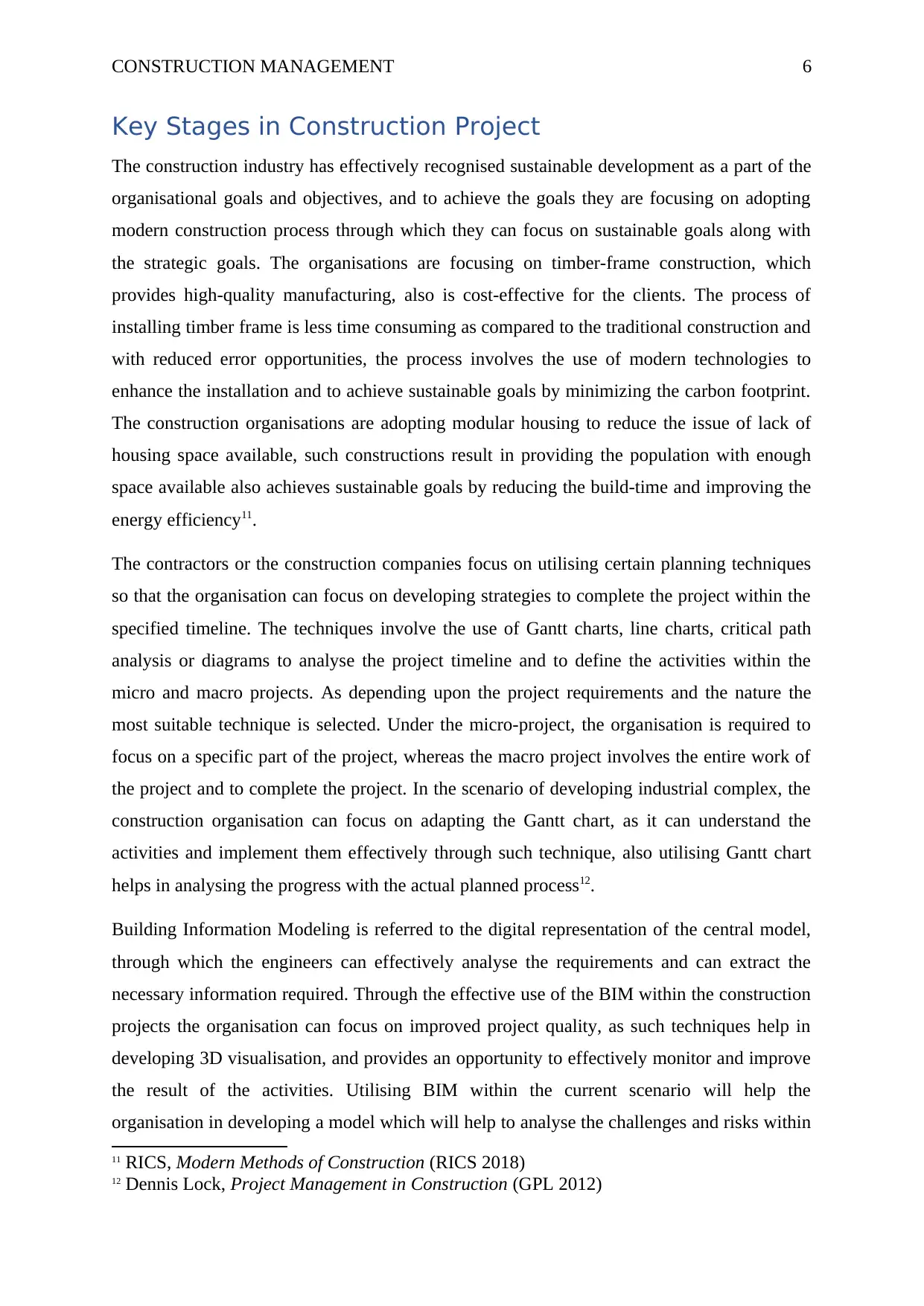
CONSTRUCTION MANAGEMENT 6
Key Stages in Construction Project
The construction industry has effectively recognised sustainable development as a part of the
organisational goals and objectives, and to achieve the goals they are focusing on adopting
modern construction process through which they can focus on sustainable goals along with
the strategic goals. The organisations are focusing on timber-frame construction, which
provides high-quality manufacturing, also is cost-effective for the clients. The process of
installing timber frame is less time consuming as compared to the traditional construction and
with reduced error opportunities, the process involves the use of modern technologies to
enhance the installation and to achieve sustainable goals by minimizing the carbon footprint.
The construction organisations are adopting modular housing to reduce the issue of lack of
housing space available, such constructions result in providing the population with enough
space available also achieves sustainable goals by reducing the build-time and improving the
energy efficiency11.
The contractors or the construction companies focus on utilising certain planning techniques
so that the organisation can focus on developing strategies to complete the project within the
specified timeline. The techniques involve the use of Gantt charts, line charts, critical path
analysis or diagrams to analyse the project timeline and to define the activities within the
micro and macro projects. As depending upon the project requirements and the nature the
most suitable technique is selected. Under the micro-project, the organisation is required to
focus on a specific part of the project, whereas the macro project involves the entire work of
the project and to complete the project. In the scenario of developing industrial complex, the
construction organisation can focus on adapting the Gantt chart, as it can understand the
activities and implement them effectively through such technique, also utilising Gantt chart
helps in analysing the progress with the actual planned process12.
Building Information Modeling is referred to the digital representation of the central model,
through which the engineers can effectively analyse the requirements and can extract the
necessary information required. Through the effective use of the BIM within the construction
projects the organisation can focus on improved project quality, as such techniques help in
developing 3D visualisation, and provides an opportunity to effectively monitor and improve
the result of the activities. Utilising BIM within the current scenario will help the
organisation in developing a model which will help to analyse the challenges and risks within
11 RICS, Modern Methods of Construction (RICS 2018)
12 Dennis Lock, Project Management in Construction (GPL 2012)
Key Stages in Construction Project
The construction industry has effectively recognised sustainable development as a part of the
organisational goals and objectives, and to achieve the goals they are focusing on adopting
modern construction process through which they can focus on sustainable goals along with
the strategic goals. The organisations are focusing on timber-frame construction, which
provides high-quality manufacturing, also is cost-effective for the clients. The process of
installing timber frame is less time consuming as compared to the traditional construction and
with reduced error opportunities, the process involves the use of modern technologies to
enhance the installation and to achieve sustainable goals by minimizing the carbon footprint.
The construction organisations are adopting modular housing to reduce the issue of lack of
housing space available, such constructions result in providing the population with enough
space available also achieves sustainable goals by reducing the build-time and improving the
energy efficiency11.
The contractors or the construction companies focus on utilising certain planning techniques
so that the organisation can focus on developing strategies to complete the project within the
specified timeline. The techniques involve the use of Gantt charts, line charts, critical path
analysis or diagrams to analyse the project timeline and to define the activities within the
micro and macro projects. As depending upon the project requirements and the nature the
most suitable technique is selected. Under the micro-project, the organisation is required to
focus on a specific part of the project, whereas the macro project involves the entire work of
the project and to complete the project. In the scenario of developing industrial complex, the
construction organisation can focus on adapting the Gantt chart, as it can understand the
activities and implement them effectively through such technique, also utilising Gantt chart
helps in analysing the progress with the actual planned process12.
Building Information Modeling is referred to the digital representation of the central model,
through which the engineers can effectively analyse the requirements and can extract the
necessary information required. Through the effective use of the BIM within the construction
projects the organisation can focus on improved project quality, as such techniques help in
developing 3D visualisation, and provides an opportunity to effectively monitor and improve
the result of the activities. Utilising BIM within the current scenario will help the
organisation in developing a model which will help to analyse the challenges and risks within
11 RICS, Modern Methods of Construction (RICS 2018)
12 Dennis Lock, Project Management in Construction (GPL 2012)
Paraphrase This Document
Need a fresh take? Get an instant paraphrase of this document with our AI Paraphraser
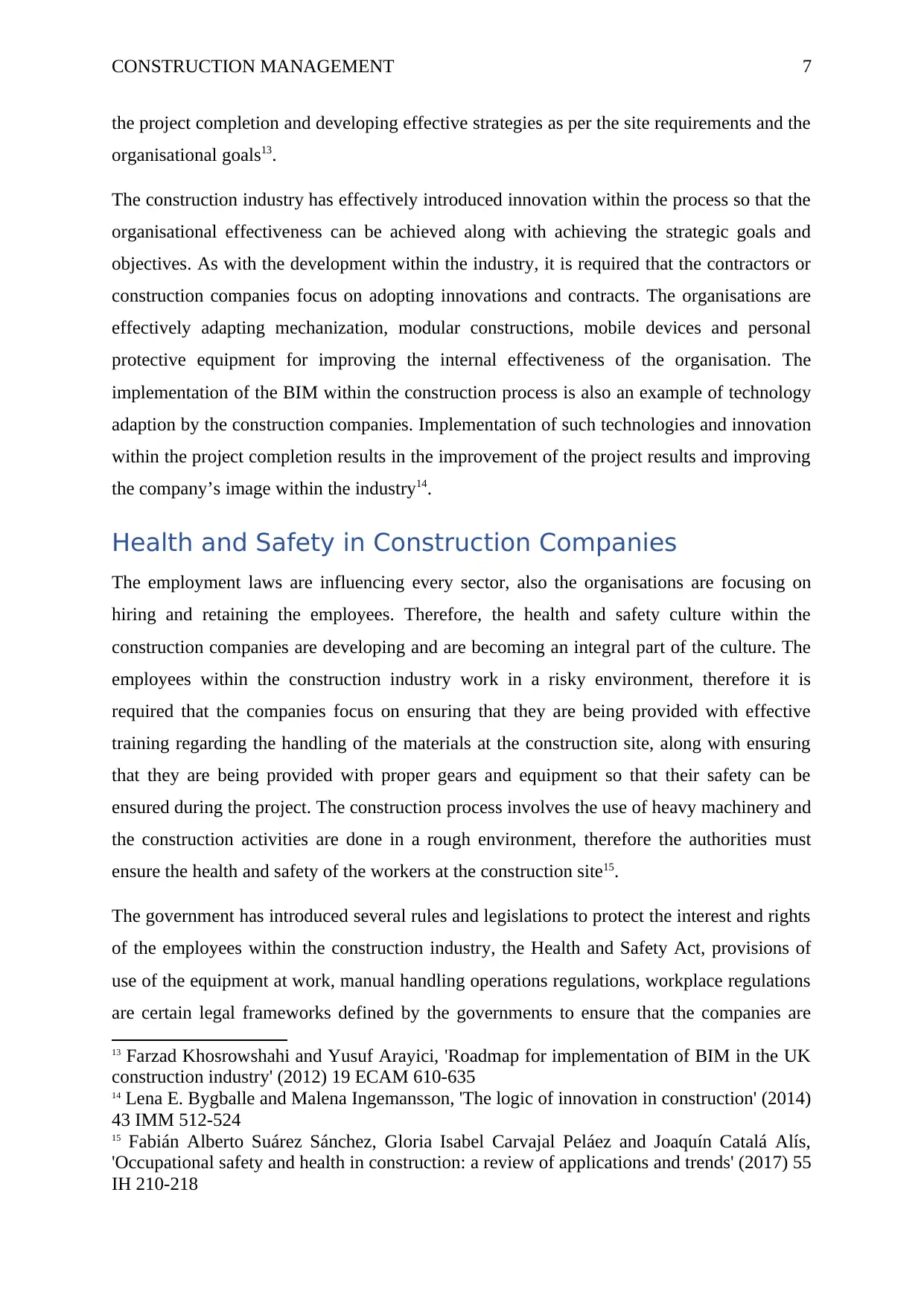
CONSTRUCTION MANAGEMENT 7
the project completion and developing effective strategies as per the site requirements and the
organisational goals13.
The construction industry has effectively introduced innovation within the process so that the
organisational effectiveness can be achieved along with achieving the strategic goals and
objectives. As with the development within the industry, it is required that the contractors or
construction companies focus on adopting innovations and contracts. The organisations are
effectively adapting mechanization, modular constructions, mobile devices and personal
protective equipment for improving the internal effectiveness of the organisation. The
implementation of the BIM within the construction process is also an example of technology
adaption by the construction companies. Implementation of such technologies and innovation
within the project completion results in the improvement of the project results and improving
the company’s image within the industry14.
Health and Safety in Construction Companies
The employment laws are influencing every sector, also the organisations are focusing on
hiring and retaining the employees. Therefore, the health and safety culture within the
construction companies are developing and are becoming an integral part of the culture. The
employees within the construction industry work in a risky environment, therefore it is
required that the companies focus on ensuring that they are being provided with effective
training regarding the handling of the materials at the construction site, along with ensuring
that they are being provided with proper gears and equipment so that their safety can be
ensured during the project. The construction process involves the use of heavy machinery and
the construction activities are done in a rough environment, therefore the authorities must
ensure the health and safety of the workers at the construction site15.
The government has introduced several rules and legislations to protect the interest and rights
of the employees within the construction industry, the Health and Safety Act, provisions of
use of the equipment at work, manual handling operations regulations, workplace regulations
are certain legal frameworks defined by the governments to ensure that the companies are
13 Farzad Khosrowshahi and Yusuf Arayici, 'Roadmap for implementation of BIM in the UK
construction industry' (2012) 19 ECAM 610-635
14 Lena E. Bygballe and Malena Ingemansson, 'The logic of innovation in construction' (2014)
43 IMM 512-524
15 Fabián Alberto Suárez Sánchez, Gloria Isabel Carvajal Peláez and Joaquín Catalá Alís,
'Occupational safety and health in construction: a review of applications and trends' (2017) 55
IH 210-218
the project completion and developing effective strategies as per the site requirements and the
organisational goals13.
The construction industry has effectively introduced innovation within the process so that the
organisational effectiveness can be achieved along with achieving the strategic goals and
objectives. As with the development within the industry, it is required that the contractors or
construction companies focus on adopting innovations and contracts. The organisations are
effectively adapting mechanization, modular constructions, mobile devices and personal
protective equipment for improving the internal effectiveness of the organisation. The
implementation of the BIM within the construction process is also an example of technology
adaption by the construction companies. Implementation of such technologies and innovation
within the project completion results in the improvement of the project results and improving
the company’s image within the industry14.
Health and Safety in Construction Companies
The employment laws are influencing every sector, also the organisations are focusing on
hiring and retaining the employees. Therefore, the health and safety culture within the
construction companies are developing and are becoming an integral part of the culture. The
employees within the construction industry work in a risky environment, therefore it is
required that the companies focus on ensuring that they are being provided with effective
training regarding the handling of the materials at the construction site, along with ensuring
that they are being provided with proper gears and equipment so that their safety can be
ensured during the project. The construction process involves the use of heavy machinery and
the construction activities are done in a rough environment, therefore the authorities must
ensure the health and safety of the workers at the construction site15.
The government has introduced several rules and legislations to protect the interest and rights
of the employees within the construction industry, the Health and Safety Act, provisions of
use of the equipment at work, manual handling operations regulations, workplace regulations
are certain legal frameworks defined by the governments to ensure that the companies are
13 Farzad Khosrowshahi and Yusuf Arayici, 'Roadmap for implementation of BIM in the UK
construction industry' (2012) 19 ECAM 610-635
14 Lena E. Bygballe and Malena Ingemansson, 'The logic of innovation in construction' (2014)
43 IMM 512-524
15 Fabián Alberto Suárez Sánchez, Gloria Isabel Carvajal Peláez and Joaquín Catalá Alís,
'Occupational safety and health in construction: a review of applications and trends' (2017) 55
IH 210-218
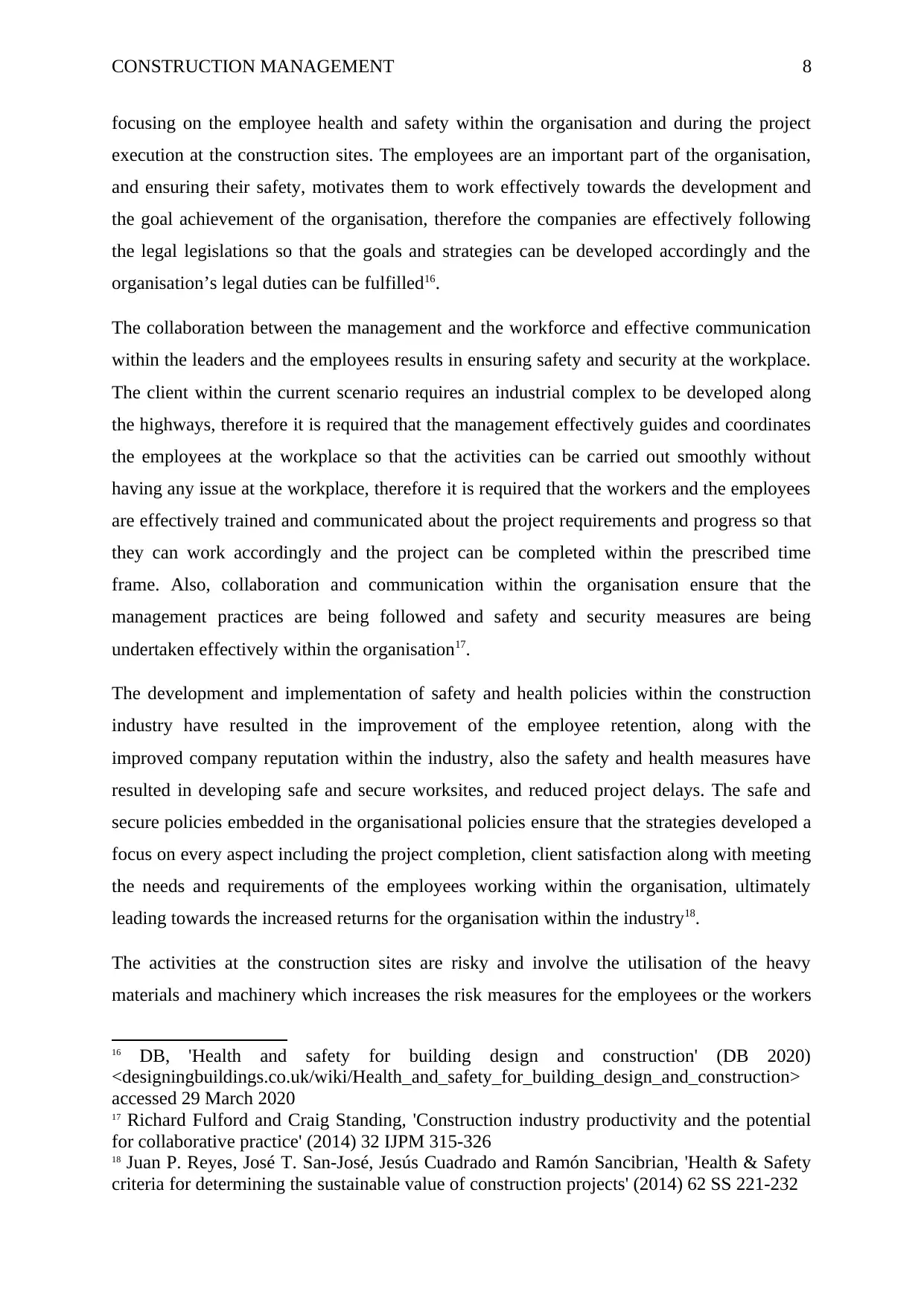
CONSTRUCTION MANAGEMENT 8
focusing on the employee health and safety within the organisation and during the project
execution at the construction sites. The employees are an important part of the organisation,
and ensuring their safety, motivates them to work effectively towards the development and
the goal achievement of the organisation, therefore the companies are effectively following
the legal legislations so that the goals and strategies can be developed accordingly and the
organisation’s legal duties can be fulfilled16.
The collaboration between the management and the workforce and effective communication
within the leaders and the employees results in ensuring safety and security at the workplace.
The client within the current scenario requires an industrial complex to be developed along
the highways, therefore it is required that the management effectively guides and coordinates
the employees at the workplace so that the activities can be carried out smoothly without
having any issue at the workplace, therefore it is required that the workers and the employees
are effectively trained and communicated about the project requirements and progress so that
they can work accordingly and the project can be completed within the prescribed time
frame. Also, collaboration and communication within the organisation ensure that the
management practices are being followed and safety and security measures are being
undertaken effectively within the organisation17.
The development and implementation of safety and health policies within the construction
industry have resulted in the improvement of the employee retention, along with the
improved company reputation within the industry, also the safety and health measures have
resulted in developing safe and secure worksites, and reduced project delays. The safe and
secure policies embedded in the organisational policies ensure that the strategies developed a
focus on every aspect including the project completion, client satisfaction along with meeting
the needs and requirements of the employees working within the organisation, ultimately
leading towards the increased returns for the organisation within the industry18.
The activities at the construction sites are risky and involve the utilisation of the heavy
materials and machinery which increases the risk measures for the employees or the workers
16 DB, 'Health and safety for building design and construction' (DB 2020)
<designingbuildings.co.uk/wiki/Health_and_safety_for_building_design_and_construction>
accessed 29 March 2020
17 Richard Fulford and Craig Standing, 'Construction industry productivity and the potential
for collaborative practice' (2014) 32 IJPM 315-326
18 Juan P. Reyes, José T. San-José, Jesús Cuadrado and Ramón Sancibrian, 'Health & Safety
criteria for determining the sustainable value of construction projects' (2014) 62 SS 221-232
focusing on the employee health and safety within the organisation and during the project
execution at the construction sites. The employees are an important part of the organisation,
and ensuring their safety, motivates them to work effectively towards the development and
the goal achievement of the organisation, therefore the companies are effectively following
the legal legislations so that the goals and strategies can be developed accordingly and the
organisation’s legal duties can be fulfilled16.
The collaboration between the management and the workforce and effective communication
within the leaders and the employees results in ensuring safety and security at the workplace.
The client within the current scenario requires an industrial complex to be developed along
the highways, therefore it is required that the management effectively guides and coordinates
the employees at the workplace so that the activities can be carried out smoothly without
having any issue at the workplace, therefore it is required that the workers and the employees
are effectively trained and communicated about the project requirements and progress so that
they can work accordingly and the project can be completed within the prescribed time
frame. Also, collaboration and communication within the organisation ensure that the
management practices are being followed and safety and security measures are being
undertaken effectively within the organisation17.
The development and implementation of safety and health policies within the construction
industry have resulted in the improvement of the employee retention, along with the
improved company reputation within the industry, also the safety and health measures have
resulted in developing safe and secure worksites, and reduced project delays. The safe and
secure policies embedded in the organisational policies ensure that the strategies developed a
focus on every aspect including the project completion, client satisfaction along with meeting
the needs and requirements of the employees working within the organisation, ultimately
leading towards the increased returns for the organisation within the industry18.
The activities at the construction sites are risky and involve the utilisation of the heavy
materials and machinery which increases the risk measures for the employees or the workers
16 DB, 'Health and safety for building design and construction' (DB 2020)
<designingbuildings.co.uk/wiki/Health_and_safety_for_building_design_and_construction>
accessed 29 March 2020
17 Richard Fulford and Craig Standing, 'Construction industry productivity and the potential
for collaborative practice' (2014) 32 IJPM 315-326
18 Juan P. Reyes, José T. San-José, Jesús Cuadrado and Ramón Sancibrian, 'Health & Safety
criteria for determining the sustainable value of construction projects' (2014) 62 SS 221-232
⊘ This is a preview!⊘
Do you want full access?
Subscribe today to unlock all pages.

Trusted by 1+ million students worldwide
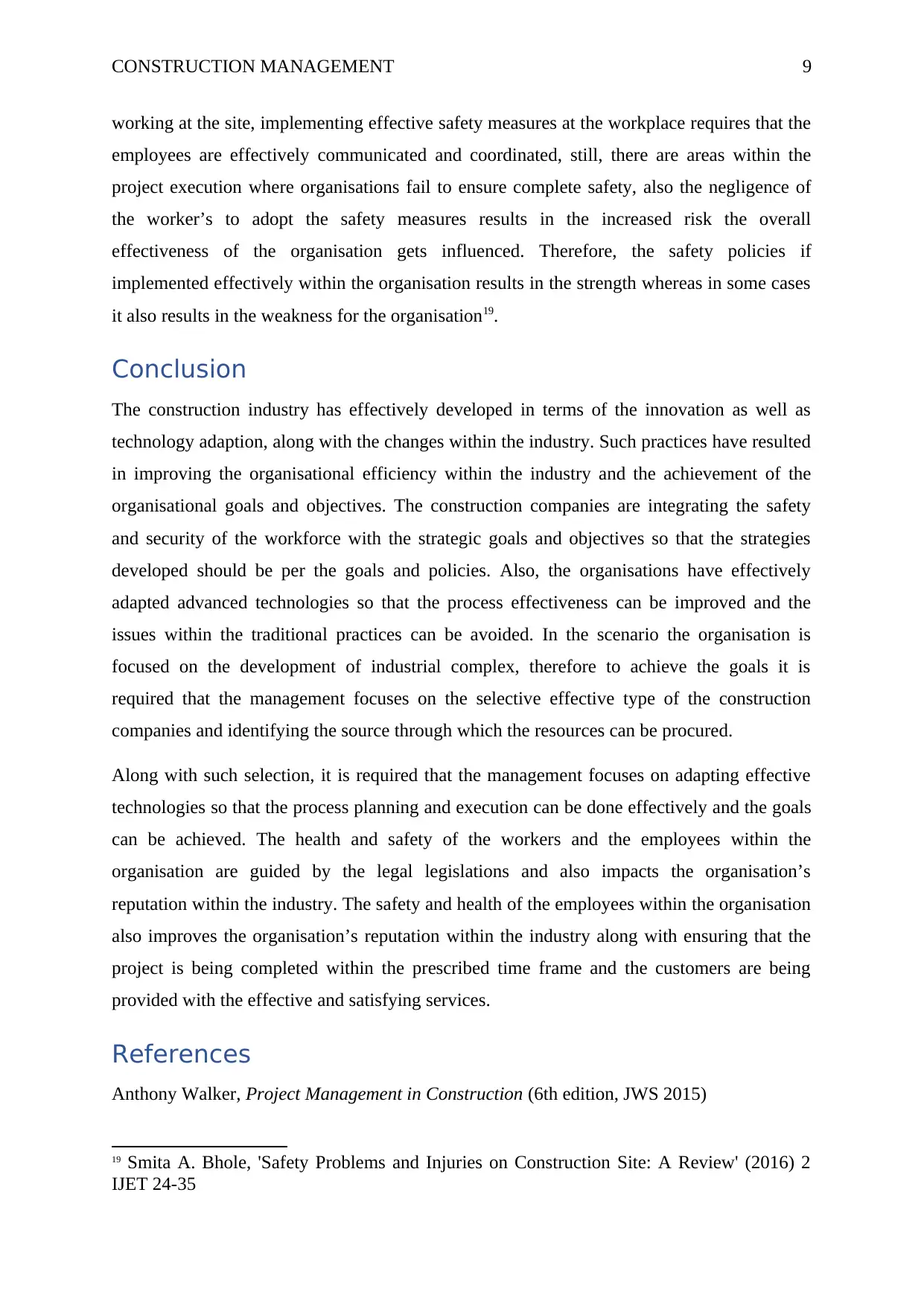
CONSTRUCTION MANAGEMENT 9
working at the site, implementing effective safety measures at the workplace requires that the
employees are effectively communicated and coordinated, still, there are areas within the
project execution where organisations fail to ensure complete safety, also the negligence of
the worker’s to adopt the safety measures results in the increased risk the overall
effectiveness of the organisation gets influenced. Therefore, the safety policies if
implemented effectively within the organisation results in the strength whereas in some cases
it also results in the weakness for the organisation19.
Conclusion
The construction industry has effectively developed in terms of the innovation as well as
technology adaption, along with the changes within the industry. Such practices have resulted
in improving the organisational efficiency within the industry and the achievement of the
organisational goals and objectives. The construction companies are integrating the safety
and security of the workforce with the strategic goals and objectives so that the strategies
developed should be per the goals and policies. Also, the organisations have effectively
adapted advanced technologies so that the process effectiveness can be improved and the
issues within the traditional practices can be avoided. In the scenario the organisation is
focused on the development of industrial complex, therefore to achieve the goals it is
required that the management focuses on the selective effective type of the construction
companies and identifying the source through which the resources can be procured.
Along with such selection, it is required that the management focuses on adapting effective
technologies so that the process planning and execution can be done effectively and the goals
can be achieved. The health and safety of the workers and the employees within the
organisation are guided by the legal legislations and also impacts the organisation’s
reputation within the industry. The safety and health of the employees within the organisation
also improves the organisation’s reputation within the industry along with ensuring that the
project is being completed within the prescribed time frame and the customers are being
provided with the effective and satisfying services.
References
Anthony Walker, Project Management in Construction (6th edition, JWS 2015)
19 Smita A. Bhole, 'Safety Problems and Injuries on Construction Site: A Review' (2016) 2
IJET 24-35
working at the site, implementing effective safety measures at the workplace requires that the
employees are effectively communicated and coordinated, still, there are areas within the
project execution where organisations fail to ensure complete safety, also the negligence of
the worker’s to adopt the safety measures results in the increased risk the overall
effectiveness of the organisation gets influenced. Therefore, the safety policies if
implemented effectively within the organisation results in the strength whereas in some cases
it also results in the weakness for the organisation19.
Conclusion
The construction industry has effectively developed in terms of the innovation as well as
technology adaption, along with the changes within the industry. Such practices have resulted
in improving the organisational efficiency within the industry and the achievement of the
organisational goals and objectives. The construction companies are integrating the safety
and security of the workforce with the strategic goals and objectives so that the strategies
developed should be per the goals and policies. Also, the organisations have effectively
adapted advanced technologies so that the process effectiveness can be improved and the
issues within the traditional practices can be avoided. In the scenario the organisation is
focused on the development of industrial complex, therefore to achieve the goals it is
required that the management focuses on the selective effective type of the construction
companies and identifying the source through which the resources can be procured.
Along with such selection, it is required that the management focuses on adapting effective
technologies so that the process planning and execution can be done effectively and the goals
can be achieved. The health and safety of the workers and the employees within the
organisation are guided by the legal legislations and also impacts the organisation’s
reputation within the industry. The safety and health of the employees within the organisation
also improves the organisation’s reputation within the industry along with ensuring that the
project is being completed within the prescribed time frame and the customers are being
provided with the effective and satisfying services.
References
Anthony Walker, Project Management in Construction (6th edition, JWS 2015)
19 Smita A. Bhole, 'Safety Problems and Injuries on Construction Site: A Review' (2016) 2
IJET 24-35
Paraphrase This Document
Need a fresh take? Get an instant paraphrase of this document with our AI Paraphraser
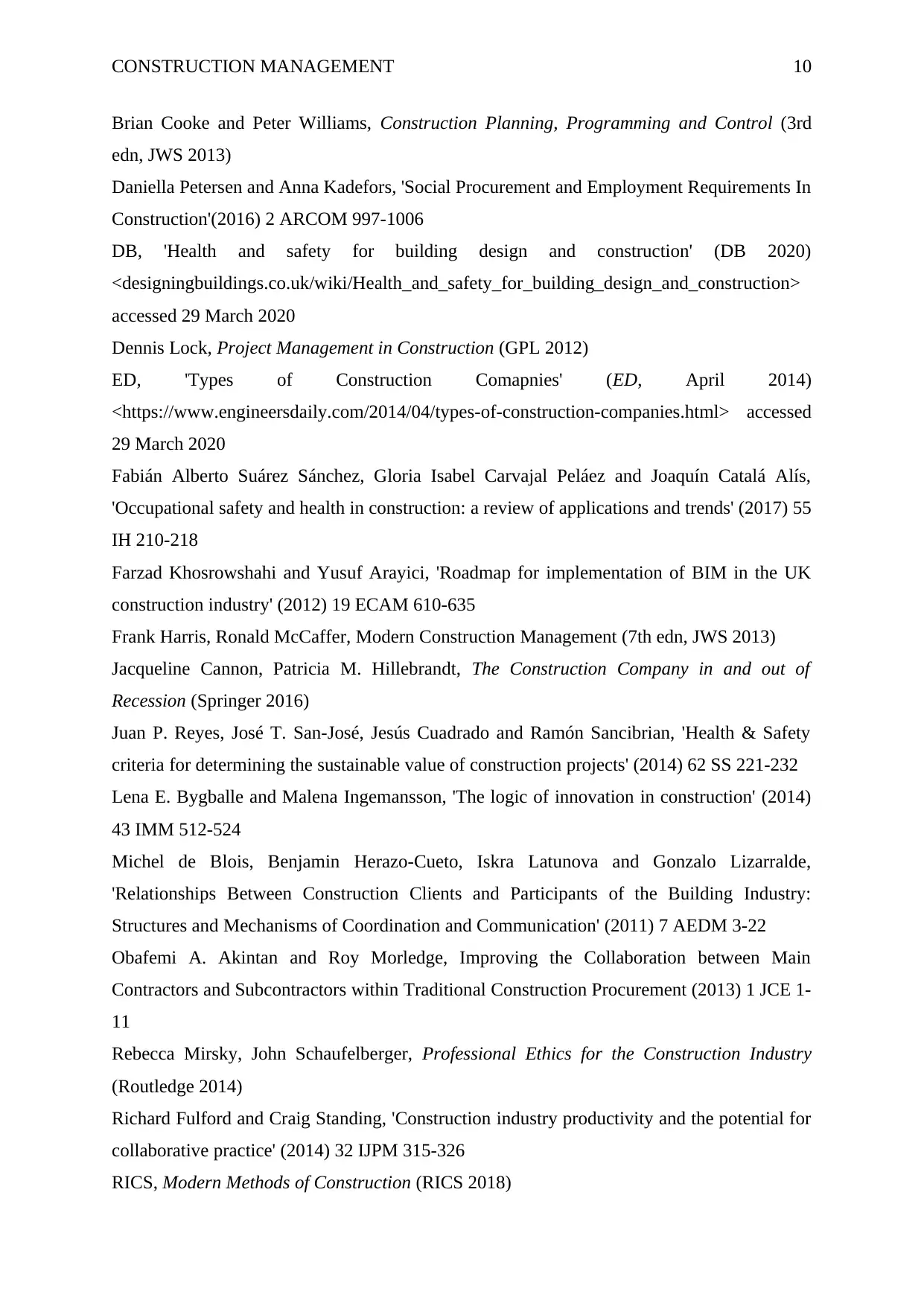
CONSTRUCTION MANAGEMENT 10
Brian Cooke and Peter Williams, Construction Planning, Programming and Control (3rd
edn, JWS 2013)
Daniella Petersen and Anna Kadefors, 'Social Procurement and Employment Requirements In
Construction'(2016) 2 ARCOM 997-1006
DB, 'Health and safety for building design and construction' (DB 2020)
<designingbuildings.co.uk/wiki/Health_and_safety_for_building_design_and_construction>
accessed 29 March 2020
Dennis Lock, Project Management in Construction (GPL 2012)
ED, 'Types of Construction Comapnies' (ED, April 2014)
<https://www.engineersdaily.com/2014/04/types-of-construction-companies.html> accessed
29 March 2020
Fabián Alberto Suárez Sánchez, Gloria Isabel Carvajal Peláez and Joaquín Catalá Alís,
'Occupational safety and health in construction: a review of applications and trends' (2017) 55
IH 210-218
Farzad Khosrowshahi and Yusuf Arayici, 'Roadmap for implementation of BIM in the UK
construction industry' (2012) 19 ECAM 610-635
Frank Harris, Ronald McCaffer, Modern Construction Management (7th edn, JWS 2013)
Jacqueline Cannon, Patricia M. Hillebrandt, The Construction Company in and out of
Recession (Springer 2016)
Juan P. Reyes, José T. San-José, Jesús Cuadrado and Ramón Sancibrian, 'Health & Safety
criteria for determining the sustainable value of construction projects' (2014) 62 SS 221-232
Lena E. Bygballe and Malena Ingemansson, 'The logic of innovation in construction' (2014)
43 IMM 512-524
Michel de Blois, Benjamin Herazo-Cueto, Iskra Latunova and Gonzalo Lizarralde,
'Relationships Between Construction Clients and Participants of the Building Industry:
Structures and Mechanisms of Coordination and Communication' (2011) 7 AEDM 3-22
Obafemi A. Akintan and Roy Morledge, Improving the Collaboration between Main
Contractors and Subcontractors within Traditional Construction Procurement (2013) 1 JCE 1-
11
Rebecca Mirsky, John Schaufelberger, Professional Ethics for the Construction Industry
(Routledge 2014)
Richard Fulford and Craig Standing, 'Construction industry productivity and the potential for
collaborative practice' (2014) 32 IJPM 315-326
RICS, Modern Methods of Construction (RICS 2018)
Brian Cooke and Peter Williams, Construction Planning, Programming and Control (3rd
edn, JWS 2013)
Daniella Petersen and Anna Kadefors, 'Social Procurement and Employment Requirements In
Construction'(2016) 2 ARCOM 997-1006
DB, 'Health and safety for building design and construction' (DB 2020)
<designingbuildings.co.uk/wiki/Health_and_safety_for_building_design_and_construction>
accessed 29 March 2020
Dennis Lock, Project Management in Construction (GPL 2012)
ED, 'Types of Construction Comapnies' (ED, April 2014)
<https://www.engineersdaily.com/2014/04/types-of-construction-companies.html> accessed
29 March 2020
Fabián Alberto Suárez Sánchez, Gloria Isabel Carvajal Peláez and Joaquín Catalá Alís,
'Occupational safety and health in construction: a review of applications and trends' (2017) 55
IH 210-218
Farzad Khosrowshahi and Yusuf Arayici, 'Roadmap for implementation of BIM in the UK
construction industry' (2012) 19 ECAM 610-635
Frank Harris, Ronald McCaffer, Modern Construction Management (7th edn, JWS 2013)
Jacqueline Cannon, Patricia M. Hillebrandt, The Construction Company in and out of
Recession (Springer 2016)
Juan P. Reyes, José T. San-José, Jesús Cuadrado and Ramón Sancibrian, 'Health & Safety
criteria for determining the sustainable value of construction projects' (2014) 62 SS 221-232
Lena E. Bygballe and Malena Ingemansson, 'The logic of innovation in construction' (2014)
43 IMM 512-524
Michel de Blois, Benjamin Herazo-Cueto, Iskra Latunova and Gonzalo Lizarralde,
'Relationships Between Construction Clients and Participants of the Building Industry:
Structures and Mechanisms of Coordination and Communication' (2011) 7 AEDM 3-22
Obafemi A. Akintan and Roy Morledge, Improving the Collaboration between Main
Contractors and Subcontractors within Traditional Construction Procurement (2013) 1 JCE 1-
11
Rebecca Mirsky, John Schaufelberger, Professional Ethics for the Construction Industry
(Routledge 2014)
Richard Fulford and Craig Standing, 'Construction industry productivity and the potential for
collaborative practice' (2014) 32 IJPM 315-326
RICS, Modern Methods of Construction (RICS 2018)
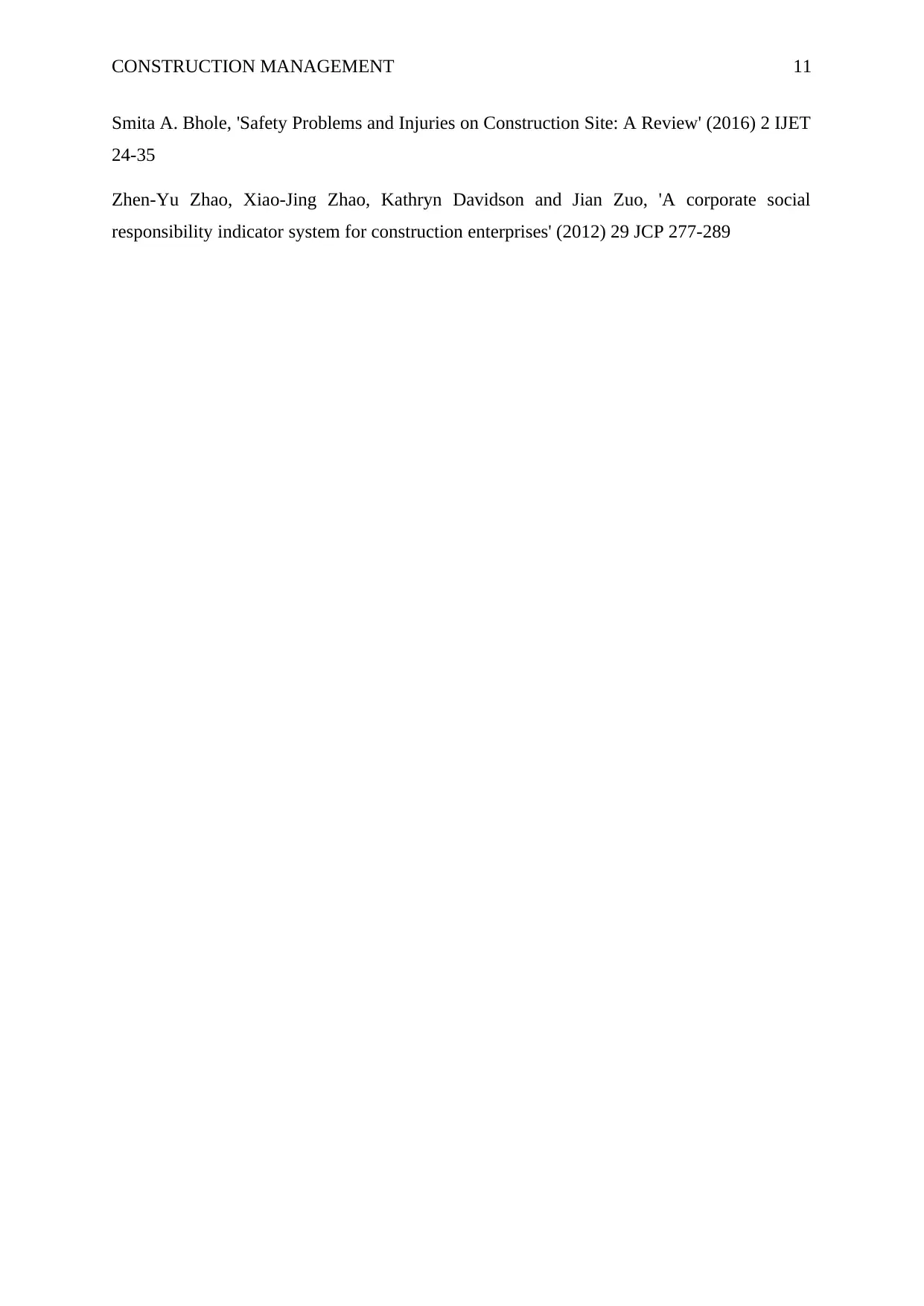
CONSTRUCTION MANAGEMENT 11
Smita A. Bhole, 'Safety Problems and Injuries on Construction Site: A Review' (2016) 2 IJET
24-35
Zhen-Yu Zhao, Xiao-Jing Zhao, Kathryn Davidson and Jian Zuo, 'A corporate social
responsibility indicator system for construction enterprises' (2012) 29 JCP 277-289
Smita A. Bhole, 'Safety Problems and Injuries on Construction Site: A Review' (2016) 2 IJET
24-35
Zhen-Yu Zhao, Xiao-Jing Zhao, Kathryn Davidson and Jian Zuo, 'A corporate social
responsibility indicator system for construction enterprises' (2012) 29 JCP 277-289
⊘ This is a preview!⊘
Do you want full access?
Subscribe today to unlock all pages.

Trusted by 1+ million students worldwide
1 out of 12
Related Documents
Your All-in-One AI-Powered Toolkit for Academic Success.
+13062052269
info@desklib.com
Available 24*7 on WhatsApp / Email
![[object Object]](/_next/static/media/star-bottom.7253800d.svg)
Unlock your academic potential
Copyright © 2020–2025 A2Z Services. All Rights Reserved. Developed and managed by ZUCOL.




